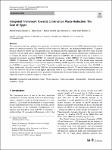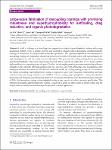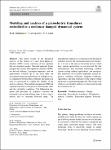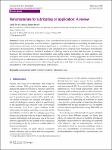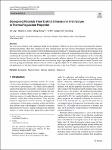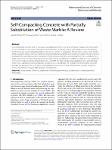Search
Author
- Amir, Ebrahimi (2)
- Aydin, Azizi (2)
- George, Haller (2)
- James, M. Fiore (2)
- next >
Subject
- robotics (9)
- Engineering (8)
- engineering (8)
- công nghệ (3)
- next >
Date issued
- 2020 - 2023 (215)
- 2010 - 2019 (28)
- 2001 - 2009 (6)
Has File(s)
- true (249)
Search Results
The construction industry is plagued with significant construction and demolition waste (C&DW) generated during various phases of construction projects. This waste has created a universal, pervasive, and enduring problem globally. To propose practical solutions to resolve this consequential issue, this research adopted a quantitative approach in two stages. The first stage involved an online survey, administrated to 360 methodically selected construction organisations working in Egypt, to evaluate the impact of six main factors on C&DW reduction (C&DWR). The six main factors are as follows: (1) materials procurement measures (MPMR); (2) materials procurement models (MPMO); (3) green building practices (GBPR); (4) legislation (LG); (5) culture and behaviour (CB); and (6) awareness (A... |
In order to demonstrate the relevance of considering Vortex-Induced Vibrations (VIV) in the structural design of marine structures, this study proposes an alternative experimental and analytical approach in wet conditions to measure the fluid–structure interaction in the near field and quantify the viscous damping with measured structural and 3D hydrodynamic accelerations. It was demonstrated that VIV caused and incremented 5.00% of the structural damping coefficient, and the extreme wind loading increased 74% of the offshore monopile’s structural damping, demonstrating the relevance of the high non-linear hydrodynamics effects during selecting parameters into the structural design in offshore applications. |
It is still a challenge to achieve large-area preparation of robust superhydrophobic surfaces with strong mechanical stability. Here, a simple and low-cost method to prepare robust decoupling superhydrophobic coatings on aluminum (Al) alloys substrate has been presented. The superhydrophobicity and robustness of decoupling coatings are realized by structuring surfaces at two different length scales, with nanostructures for superhydrophobicity and microstructures for robustness. This prepared decoupling coating shows promising superhydrophobicity, with water contact angle (CA) of ∼158.4° and roll off angle (RA) of ∼3°. |
A data-driven algorithm is proposed for flow reconstruction from sparse velocity and/or scalar measurements. The algorithm is applied to the flow around a two-dimensional, wall-mounted, square prism. To reduce the problem dimensionality, snapshots of flow and scalar fields are processed to derive POD modes and their time coefficients. Then a system identification algorithm is employed to build a reduced order, linear, dynamical system for the flow and scalar dynamics. Optimal estimation theory is subsequently applied to derive a Kalman estimator to predict the time coefficients of the POD modes from sparse measurements. Analysis of the flow and scalar spectra demonstrate that the flow field leaves its footprint on the scalar, thus extracting velocity from scalar concentration measur... |
This paper focuses on the dynamical analysis of the motion of a new three-degree-of-freedom (DOF) system consisting of two segments that are attached together. External harmonic forces energize this system. The equations of motion (EOM) are derived utilizing Lagrangian equations, and the approximate solutions up to the third order are investigated using the methodology of multiple scales. A comparison between these solutions and numerical ones is constructed to confirm the validity of the analytic solutions. The modulation equations (ME) are acquired from the investigation of the resonance cases and the solvability conditions. The bifurcation diagrams and spectrums of Lyapunov exponent are presented to reveal the different types of the system’s motion and to represent Poincaré maps.... |
This article is licensed under a Creative Commons Attribution 4.0 International License, which permits use, sharing, adaptation, distribution and reproduction in any medium or format, as long as you give appropriate credit to the original author(s) and the source, provide a link to the Creative Commons licence, and indicate if changes were made. The images or other third party material in this article are included in the article's Creative Commons licence, unless indicated otherwise in a credit line to the material. |
Friction and wear are ubiquitous, from nano-electro-mechanical systems in biomedicine to large-scale integrated electric propulsion in aircraft carriers. Applications of nanomaterials as lubricating oil additives have achieved great advances, which are of great significance to control friction and wear. This review focuses on the applications of nanomaterials in lubricating oil and comprehensively compares their tribological characteristics as lubricating oil additives. Statistical analysis of tribology data is provided and discussed accordingly; moreover, the interaction between nanomaterials and sliding surface, lubricating oil, other additives, and synergistic lubrication in nanocomposites are systematically elaborated. Finally, suggestions for future research on nanomaterials as... |
The structural evolutions of the organisms during the development of billions of years endow them with remarkable thermal-regulation properties, which have significance to their survival against the outer versatile environment. Inspired by the nature, there have been extensive researches to develop thermoregulating materials by mimicking and utilizing the advantages from the natural organisms. In this review, the latest advances in thermal regulation of bioinspired microstructures are summarized, classifying the researches from dimension. The representative materials are described with emphasis on the relationship between the structural features and the corresponding thermal-regulation functions. For one-dimensional materials, wild silkworm cocoon fibers have been involved, and the ... |
This study presents the use of sawdust ash as a substitute in the production of sustainable building materials. Inappropriate dispose of wood-waste causes serious environmental problems as it results in atmospheric degradation, emissions of greenhouse gases and the destruction of aquatic and organic products. This review article combines research results from past studies into the usage of sawdust as an alternative for essential elements in construction composites. The result of this study shows that structural concrete can be manufactured with compressive strengths more than 20 MPa by replacing moderately 5–17% of the sand with sawdust or 5–15% of the cement with sawdust ash. By partially substituting sawdust that ranges between 10 and 30% of sand used in the production of blocks a... |
Self-compacting concrete (SCC) is also seen as unsustainable since it uses a lot of natural resources. Recent researchers have focused on lowering construction costs and partially replacing cement with industrial waste. It is possible to effectively use various industrial wastes in concrete as cement or aggregates. Among these wastes, waste marble (WM) is a useful choice, and researchers have been interested in using WM in concrete for a couple of years. However, to pinpoint the advantages and recent advancements of research on WM as an ingredient of SCC, a comprehensive study is necessary. Therefore, the purpose of this study is to do a compressive evaluation of WM as an SCC ingredient. |

